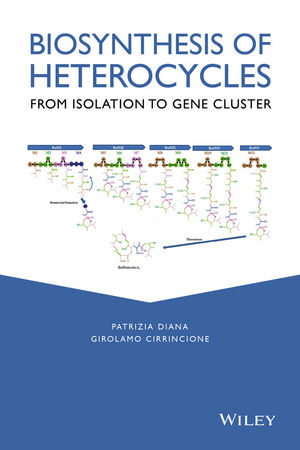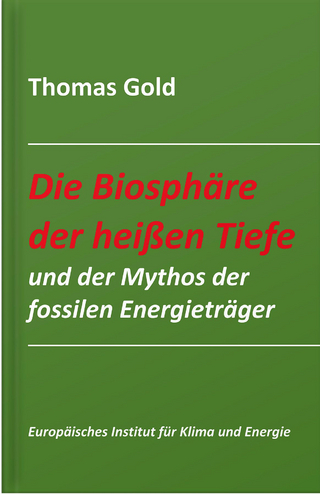
Biosynthesis of Heterocycles
John Wiley & Sons Inc (Verlag)
978-1-118-02867-4 (ISBN)
• Covers methods and techniques: isotopic labelling, enzymes and mutants, and pathway identification
• Provides a thorough resource of information specifically on heterocyclic natural products and their practical biosynthetic relevance
• Explains the role of natural products in chemistry and their formation
• Discusses gene cluster identification and the use of biogenetic engineering in pharmaceutical application
Patrizia Diana is full Professor of Medicinal Chemistry at the University of Palermo. She is currently coordinator of the Medicinal and Biological Section of the Department of Science and Technology: Chemical, Biological, and Pharmaceutical (STEBICEF); and is a member of the Italian Chemical Society and International Society of Heterocyclic Chemistry. Girolamo Cirrincione is full Professor of Medicinal Chemistry at the University of Palermo. He is a member of the Drug Discovery Committee of the Pharmacology and Molecular Mechanisms (PAMM)Group of the European Organization for Research and Treatment of Cancer; the Italian Chemical Society, where he is currently serving as President of the Medicinal Chemistry Division; and the International Society of Heterocyclic Chemistry, where he served as vice president for 2004–05
PREFACE xiii
ACKNOWLEDGMENTS xv
1 Introduction 1
1.1 Natural Products: Primary and Secondary Metabolites 4
1.2 Common Reactions in Secondary Metabolites 6
1.2.1 Alkylations 6
1.2.2 Wagner–Meerwein Rearrangements 16
1.2.3 Aldol and Claisen Reactions 17
1.2.4 Schiff Base Formation and Mannich Reactions 23
1.2.5 Transaminations 25
1.2.6 Decarboxylations 26
1.2.7 Oxidation and Reduction Reactions 31
1.2.8 Dehalogenation/Halogenation Reactions 39
1.2.9 Glycosylation Reactions 46
References 48
2 Techniques for Biosynthesis 51
2.1 Isotopic Labeling 52
2.1.1 Stable Isotopes 52
2.1.2 Radioactive Isotopes 61
2.2 Gene Coding for Enzymes 62
2.3 Combinatorial Biosynthesis 63
References 70
3 Three-Membered Heterocyclic Rings and Their Fused Derivatives 73
3.1 Aziridines and Azirines 73
3.1.1 Azicemicins 73
3.1.2 Miraziridine 74
3.1.3 Maduropeptin 75
3.1.4 Azinomycins 79
3.1.5 Ficellomycin 87
3.1.6 Mitomycins 89
3.1.7 Azirinomycin and Related Azirines 101
3.2 Oxiranes and Oxirenes 104
3.2.1 Fosfomycin 104
3.2.2 AK HC and AF toxins 111
3.2.3 Cerulenin 117
3.2.4 Polyhydroxyalkanoates 118
3.2.5 Epoxyrollins 118
3.2.6 Asperlactone Aspyrone Asperline 121
3.2.7 Tajixanthone 129
3.2.8 Cyclomarin 133
3.2.9 Cyclopenin 139
3.2.10 Ovalicin and Fumagillin 141
3.2.11 Methylenomycin A 143
3.2.12 Antibiotic LL-C10037 147
3.2.13 Manumycins 151
3.2.14 Scopolamine 164
3.2.15 Iridoid Glucosides 169
3.2.16 Cordiaquinone 172
3.2.17 Cyclizidine and Indolizomycin 172
3.2.18 Enediyne Antibiotics 175
3.2.19 Macrolides 195
3.2.20 Epothilones 225
3.2.21 Pimaricin 233
3.2.22 Hypothemycin 240
3.2.23 Radicicol and Monocillin I 243
3.2.24 Trichothecenes 248
3.2.25 Sporolides A and B 255
References 258
4 Four-Membered Heterocyclic Rings and Their Fused Derivatives 277
4.1 Azetidine and Azetines 277
4.1.1 Azetidine-2-carboxylic acid 277
4.1.2 Polyoxins 280
4.1.3 Mugineic Acids 288
4.1.4 Tabtoxin and Tabtoxinine-β-lactam 293
4.1.5 Nocardicins 296
4.1.6 Thienamycin 303
4.1.7 Clavulanic Acid and Clavams 311
4.1.8 Penicillins and Cephalosporins 319
4.2 Oxetanes 341
4.2.1 Oxetanocins 341
4.2.2 Salinosporamides 342
4.2.3 Taxol 352
4.3 Dithiethanes 363
4.3.1 Tropodithietic acid and Thiotropocin 363
References 367
5 Five-Membered Heterocyclic Rings and Their Fused Derivatives 379
5.1 Pyrroles (Including Tetrapyrroles) 379
5.1.1 2-Acetyl-1-pyrroline 379
5.1.2 Pyrrolnitrin 380
5.1.3 Broussonetines 385
5.1.4 Prodigiosin and Undecylprodigiosin 386
5.1.5 Anatoxin-a and Homoanatoxin-a 402
5.1.6 Nostopeptolides A 407
5.1.7 Pyrrolizidine Alkaloids 410
5.1.8 Toyocamycin and Sangivamycin 416
5.1.9 Tetrapyrroles 420
5.2 Indoles 428
5.2.1 Indole-3-acetic acid and Glucobrassicin 428
5.2.2 Camalexin 439
5.2.3 Cyclomarazines 444
5.2.4 Rebeccamycin and Staurosporine 445
5.2.5 Paxilline 455
5.3 Furans 460
5.3.1 Furanomycin 460
5.3.2 Xenofuranones A and B 462
5.3.3 Acyl α-L-Rhamnopyranosides and Rhamnosyllactones 463
5.3.4 Tuscolid and Tuscoron A and B 466
5.3.5 Tetronomycin and Tetronasin 469
5.3.6 Nonactin and Macrotetrolides 474
5.3.7 Furanonaphthoquinone I 481
5.4 Thiophenes 488
5.5 Pyrazoles 489
5.6 Imidazoles 490
5.6.1 Histidine 490
5.6.2 Amaranzole A 493
5.6.3 Oroidin 493
5.6.4 Nikkomycins 493
5.6.5 Anosmine 496
5.7 Thiazoles 497
5.7.1 Thiamin (Vitamin B1) 497
5.7.2 Polypeptide Antibiotics 502
5.7.3 Barbamide 508
5.7.4 BE-10988 508
5.7.5 Pheomelanins 510
5.8 Dithioles 511
References 516
6 Six-Membered Rings and Their Fused Derivatives 533
6.1 Pyridines and Piperidines 533
6.1.1 Pyridoxal 5′-phosphate 533
6.1.2 Nicotinamide Adenine Dinucleotide 536
6.1.3 Nicotine and Related Compounds 540
6.1.4 Tropane Alkaloids 542
6.1.5 Stenusine 543
6.1.6 Antidesmone 546
6.1.7 Quinolobactin 546
6.1.8 Pyridomycin 546
6.1.9 Lycopodine 550
6.1.10 Acridone Alkaloids 551
6.1.11 Benzylisoquinolines 551
6.1.12 Saframycins 559
6.2 Pyrans 561
6.2.1 Lovastatin and Compactin 561
6.2.2 Bafilomycins and Concanamycin 567
6.2.3 Citrinin 571
6.2.4 Aminocoumarin Antibiotics 571
6.2.5 Flavonoids 577
6.2.6 Actinorhodin and Granaticin 581
6.2.7 Trichothecenes 582
6.2.8 Gilvocarcins 582
6.3 Pyridazines 586
6.3.1 Kutznerides 586
6.3.2 Pyridazomycin 591
6.3.3 Azamerone 591
6.4 Pyrimidines 592
6.4.1 Purine and Pyrimidine Nucleotides 592
6.4.2 Methylxanthines and Methyluric Acids 602
6.4.3 Cytokinins 606
6.4.4 Uridyl Peptide Antibiotics 607
6.4.5 Riboflavin FMN and FAD 611
6.5 Pyrazines 613
6.5.1 Alkyl and Methoxy Pyrazines 613
6.5.2 Pteridines 616
6.5.3 Epipolythiodioxopiperazines 617
6.5.4 Roquefortine C and Related Compounds 621
6.6 Oxazines 622
6.6.1 Minimycin 622
6.6.2 Benzoxazinoids 625
6.7 Dioxanes 626
6.7.1 Plakortolides 626
6.7.2 Alnumycin 627
References 632
7 Seven- Eight-Membered and Larger Heterocyclic Rings and Their Fused Derivatives 649
7.1 Azepines 649
7.2 Oxepanes and Oxepines 657
7.3 Diazepines Oxazepines and Thiazepines 661
7.4 Diazocines 674
7.5 Oxocines 674
7.6 Erythromycin A 675
7.7 Tylosin 683
7.8 Zearalenone 690
7.9 Polyene Macrolide Antibiotics 693
7.9.1 Nystatin and Amphotericin 694
7.9.2 Candicidin D 705
7.10 Geldanamycin and Herbimycins 716
7.11 Rifamycins 724
7.12 Rapamycin 738
References 745
INDEX 757
| Erscheint lt. Verlag | 7.4.2015 |
|---|---|
| Verlagsort | New York |
| Sprache | englisch |
| Maße | 158 x 236 mm |
| Gewicht | 1179 g |
| Themenwelt | Naturwissenschaften ► Biologie ► Biochemie |
| Naturwissenschaften ► Chemie ► Organische Chemie | |
| ISBN-10 | 1-118-02867-8 / 1118028678 |
| ISBN-13 | 978-1-118-02867-4 / 9781118028674 |
| Zustand | Neuware |
| Informationen gemäß Produktsicherheitsverordnung (GPSR) | |
| Haben Sie eine Frage zum Produkt? |
aus dem Bereich


